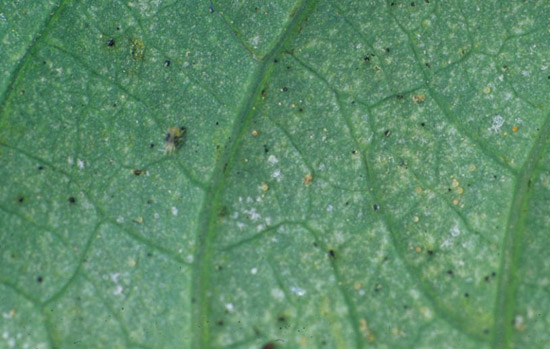Issue 12, July 25, 2011
Twospotted Spidermite
Twospotted spidermites become numerous and thrive in hot, dry weather. They are attacked and killed by fungal diseases that do better in moist conditions. The spidermites take longer to grow up in cooler conditions, giving the fungi more time to kill the mites.
Twospotted spidermites are recognized easiest by the damage that they cause. They and the related oak mite and honeylocust mite feed on broadleaved plants, both deciduous and evergreen. Damage appears as light, stippled areas that later turn brown on the upper and lower leaf surfaces. The mites live primarily on the leaf undersides, giving the leaf underside a slightly dirty appearance. Close examination with a hand lens reveals the eight-legged mites and spherical whitish to yellowish eggs on the leaf underside along with very fine silk webbing. The eggs are similar in size to the adult mites which are so small that about 60 will fit on a pinhead.

Scout for spidermites by holding a white sheet of paper under the branch and hitting it sharply. This knocks mites off of the foliage onto the paper where they can be more easily seen. Spidermites tend to be grayish or greenish and slow-moving. Faster moving red or light-colored mites are usually predators of the spidermites. Twospotted spidermites are also called red spidermites, being red when they grow up in cool conditions. With these mites being summer pests, it is rare to find red twospotted spidermites in Illinois. Sliding your hand across the paper will crush the mites. Spidermites streak green and predatory mites streak red or white. Numerous predatory mites will probably control the spidermites without the need for miticide applications.

Spidermites are controlled with two or three miticide sprays applied at five to seven day intervals. Most miticides do not kill the eggs, so the repeated spray is meant to kill those that have hatched from the eggs before they become adults and lay more eggs. In hot weather, the mites grow up quickly, so a delay of only a day or two beyond a seven day spray interval is likely to require an additional spray application. Effective miticides include abamectin (Avid), acequinocyl (Shuttle), bifenthrin (Onyx, Talstar), etoxazole (TetraSan), hexythiazox (Hexygon), insecticidal soap, spiromesifen (Forbid), and summer oil. (Phil Nixon)
Author:
Phil Nixon